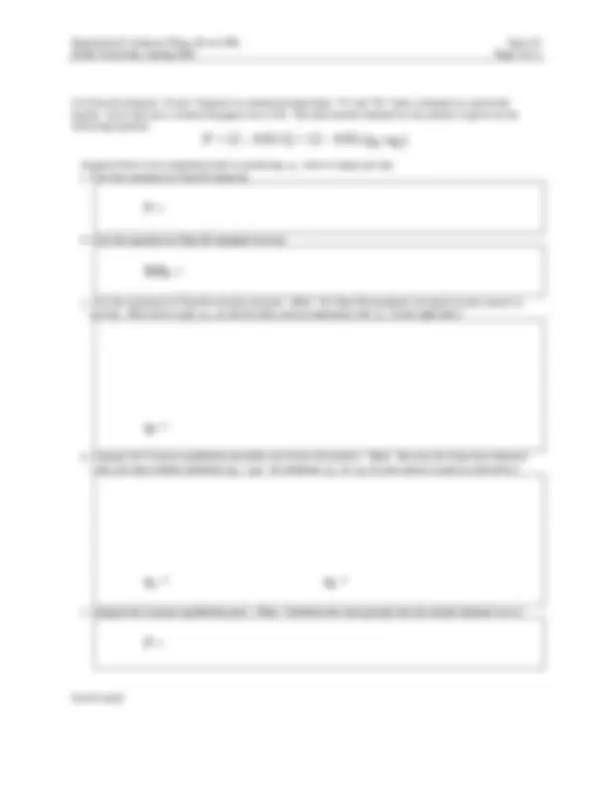



Study with the several resources on Docsity

Earn points by helping other students or get them with a premium plan


Prepare for your exams
Study with the several resources on Docsity

Earn points to download
Earn points by helping other students or get them with a premium plan
Community
Ask the community for help and clear up your study doubts
Discover the best universities in your country according to Docsity users
Free resources
Download our free guides on studying techniques, anxiety management strategies, and thesis advice from Docsity tutors
A quiz from drake university's econ 198: regulation & antitrust policy course, held in spring 2005. The quiz, titled 'oligopoly and collusion', covers topics such as market demand, marginal revenue, output quotas, joint marginal cost, and the lerner index. The quiz consists of multiple-choice questions and problems, and is closed-book and closed-notes. The maximum total points are 100.
Typology: Quizzes
1 / 3

This page cannot be seen from the preview
Don't miss anything!


Regulation & Antitrust Policy (Econ 198) Signature: Drake University, Spring 2005 William M. Boal Printed name:
INSTRUCTIONS: This exam is closed-book, closed-notes. Simple calculators are permitted, but graphing calculators or calculators with alphabetical keyboards are NOT permitted. Numerical answers, if rounded, must be correct to at least 3 significant digits. Point values for each question are noted in brackets. Maximum total points are 100. I. Multiple choice: Circle the one best answer to each question. [4 pts each: 48 pts total] (1) Suppose market demand is given by the formula P = 12 – Q/100, where P denotes the market price and Q denotes the total market quantity. Let qA denote the quantity produced by Firm A. If Firm A believes its rivals will produce 400 units, then Firm A's marginal revenue is given by a. MRA = 12 – (qA/100). b. MRA = 12 - (qA/50). c. MRA = 8 – (qA/100). d. MRA = 8 – (qA/50). (2) If five firms want to produce 100 units of output at minimum combined total cost, they should set their output quotas so that a. each firm produces 20 units. b. all five firms have the same total cost. c. all five firms have the same average cost. d. all five firms have the same marginal cost. (3) Firm A and Firm B want to produce 100 units of output at minimum combined total cost. The firms initially divide output responsibilities evenly so that each firm is producing 50 units. Firm A's marginal cost is $20 per unit, while Firm B's marginal cost is $30 per unit. The two firms can reduce their combined total cost if a. Firm A increases output and Firm B decreases output. b. Firm A decreases output and Firm B increases output. c. Combined total cost is already minimized. d. Cannot be determined from the information given. (4) The "joint marginal cost" curve under the model of joint profit maximization is the same as the a. marginal revenue curve under monopoly. b. supply curve under price competition. c. market demand curve under Cournot oligopoly. d. none of the above. (5) AFter firms agree to maximize their joint profits, each firm will have an incentive to cheat on any agreement by quietly a. lowering its price. b. raising its price. c. lowering its output level. d. any of the above. (6) The Cournot model of oligopoly assumes that each firm maximizes its profit while taking its rivals' a. prices as given. b. output quantities as given. c. costs as given. d. all of the above. (7) One implication of the Cournot model of oligopoly is that the equilibrium price is lower a. the more firms are in the industry. b. the more elastic is market demand. c. both of the above. d. none of the above. (8) A certain industry is served by a symmetric Cournot oligopoly of 5 firms. If the elasticity of market demand is -2, the Lerner index (or "price-cost margin") in equilibrium equals a. 0.. b. 0.. c. 0.. d. 0..
Regulation & Antitrust Policy (Econ 198) Quiz # Drake University, Spring 2005 Page 2 of 3 (9) According to the Cournot model of oligopoly, if firms have different marginal costs, then the firm with the lowest marginal cost has the a. smallest market share. b. largest market share. c. same market share as all other firms. d. lowest price. (10) Which market model predicts the largest quantity of total output? a. Price competition. b. Collusion to maximize joint profits. c. Cournot oligopoly. d. All models predict the same quantity of output, if all use the same assumptions about market demand and marginal cost. (11) Which market model predicts the highest equilibrium price? a. Price competition. b. Collusion to maximize joint profits. c. Cournot oligopoly. d. All models predict the same equilibrium price, if all use the same assumptions about market demand and marginal cost. (12) Under U.S. law, price-fixing is illegal a. always, except in industries Congress has exempted. b. if prices are raised significantly above marginal cost. c. if total market quantity is reduced significantly below the competitive quantity. d. if significant deadweight loss can be proven. II. Problems: Insert your answer to each question below in the box provided. Feel free to use the margins for scratch workonly the answers in the boxes will be graded. Work carefullypartial credit is not normally given for questions in this section. (1) [Collusion: 24 pts] Four package delivery companies all serve a particular route between two cities. Daily market demand and joint marginal cost are shown in the graph below.
Quantity Price Demand Joint marginal cost First, suppose the four companies collude and manage jointly to maximize the sum of their profits.